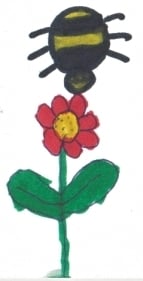A Study on the Spontaneous Representation of Animals in Young Children’s Drawings of Plant Life
Abstract
:1. Introduction
- (a)
- Firstly, to examine the content of the drawings undertaken by the children in the sample on the issue of plant life in order to determine the frequency of the depictions of animals in their drawings on this issue, broken down by the types of animals (that is, vertebrate or invertebrate).
- (b)
- Secondly, to look into the representation of animals found in children’s illustrations to elucidate whether they express some kind of interaction between plants and animals and, if so, what kind of interactions are displayed.
- (c)
- Finally, the gender and educational level variables will be examined in the sense of considering whether these variables show any relationship with the frequency and type of animals drawn as well as, if applicable, with the expression of interactions between plants and animals.
2. Method
2.1. Sample
2.2. Data Collection
2.3. Statistical Procedures
- (a)
- Whether or not any pictorial elements related to plant life appeared (for instance, flowers, grass, trees, or vegetables).
- (b)
- Whether or not, at least one vertebrate animal appeared in the drawing. The kind of vertebrate animal drawn in each picture was also registered.
- (c)
- Whether or not, at least one invertebrate animal appeared in the drawing. The kind of invertebrate drawn in each picture was also registered.
- (d)
- Whether or not any interaction between plants and animals can be identified in the drawing. The kind of interaction drawn in each picture was also registered.
3. Results
4. Conclusions
Acknowledgments
Author Contributions
Conflicts of Interest
Appendix
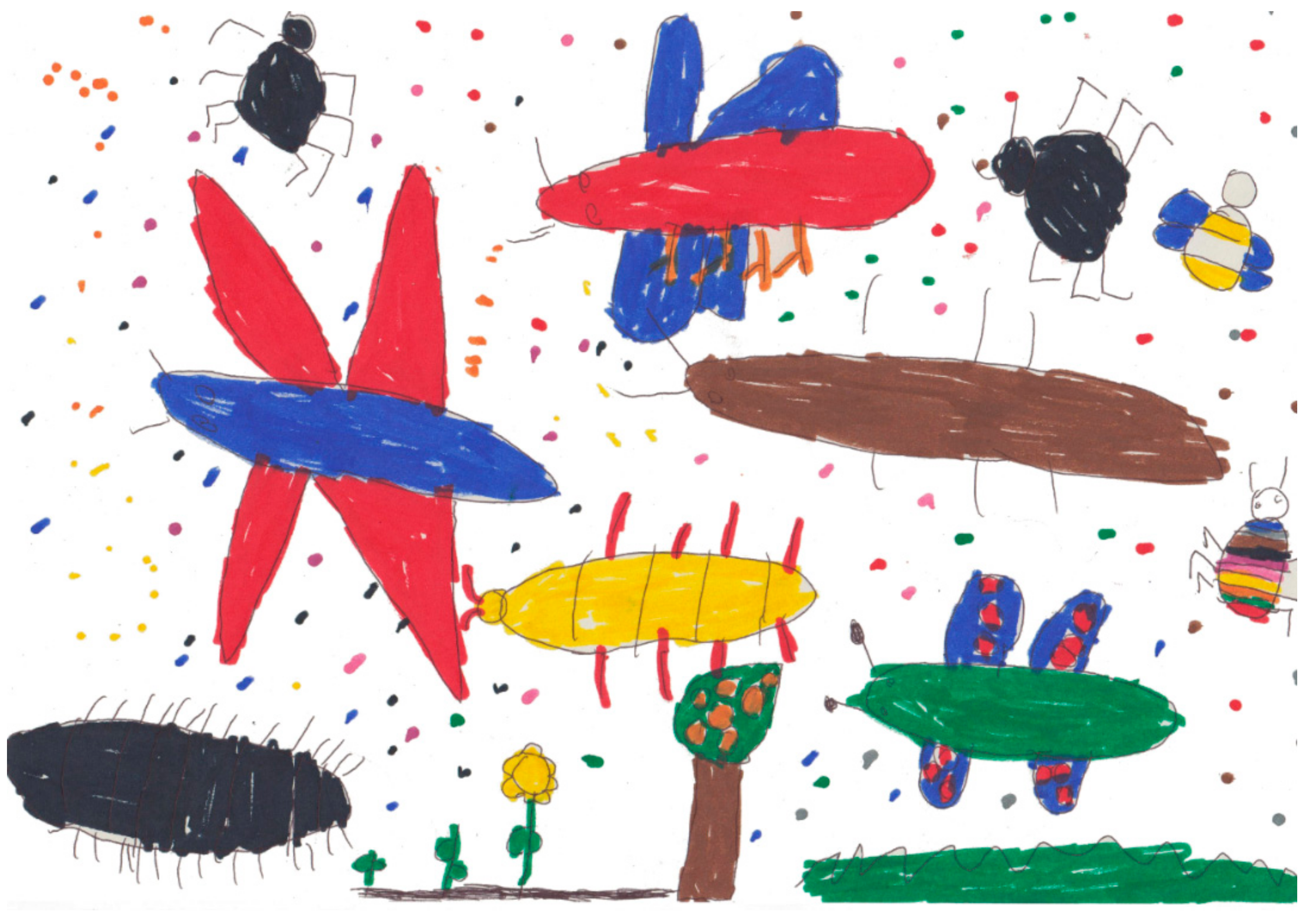
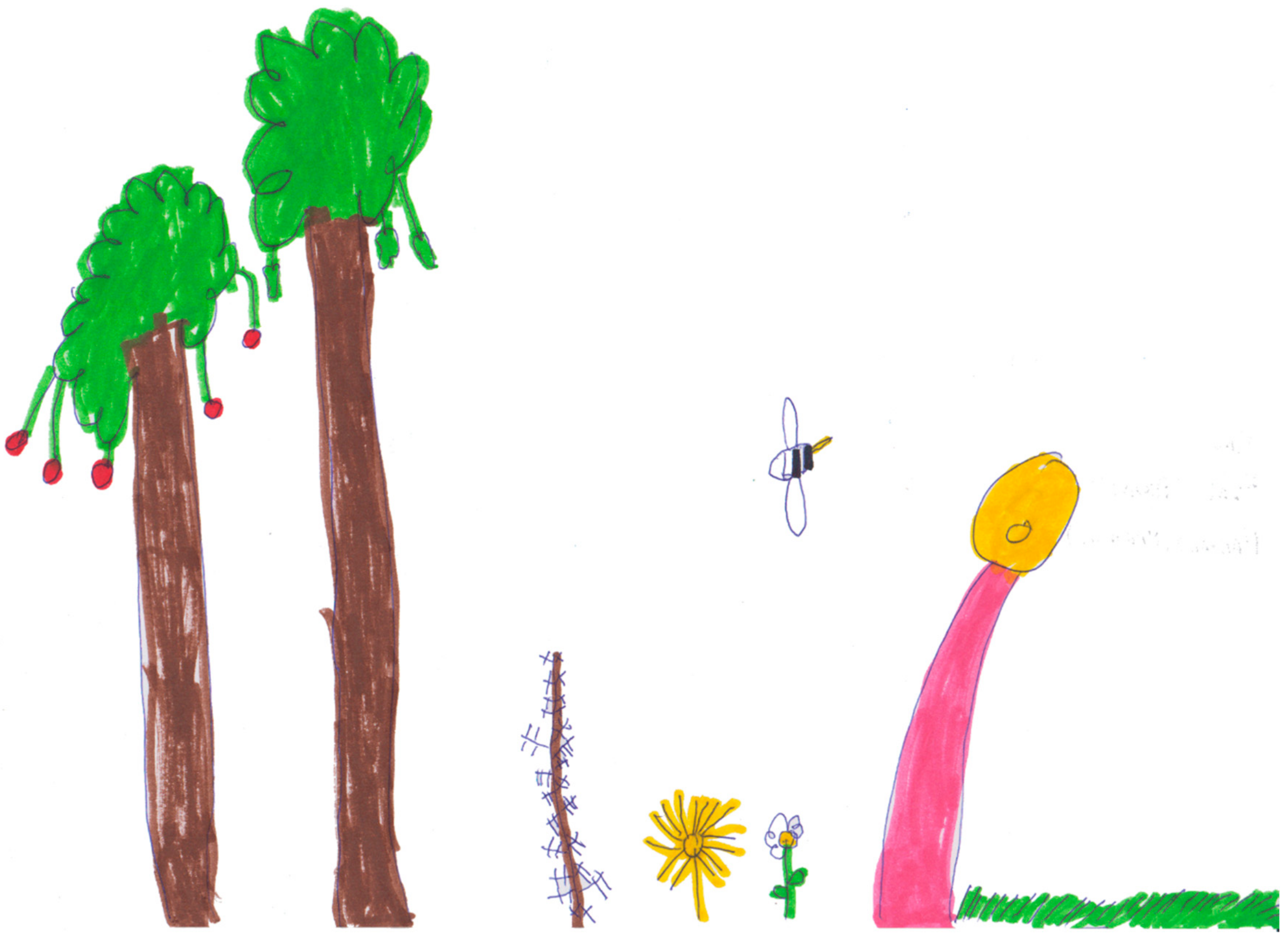
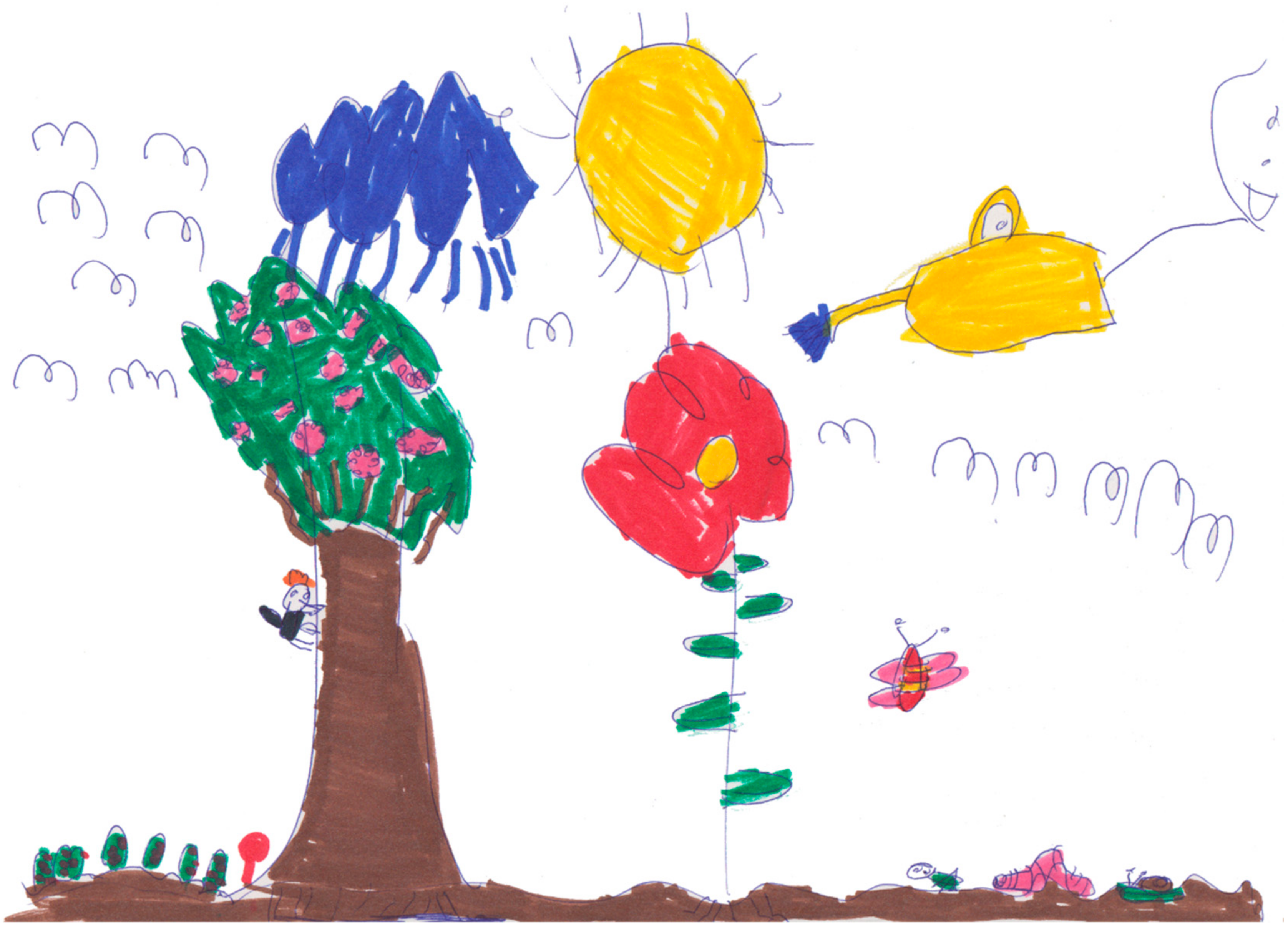
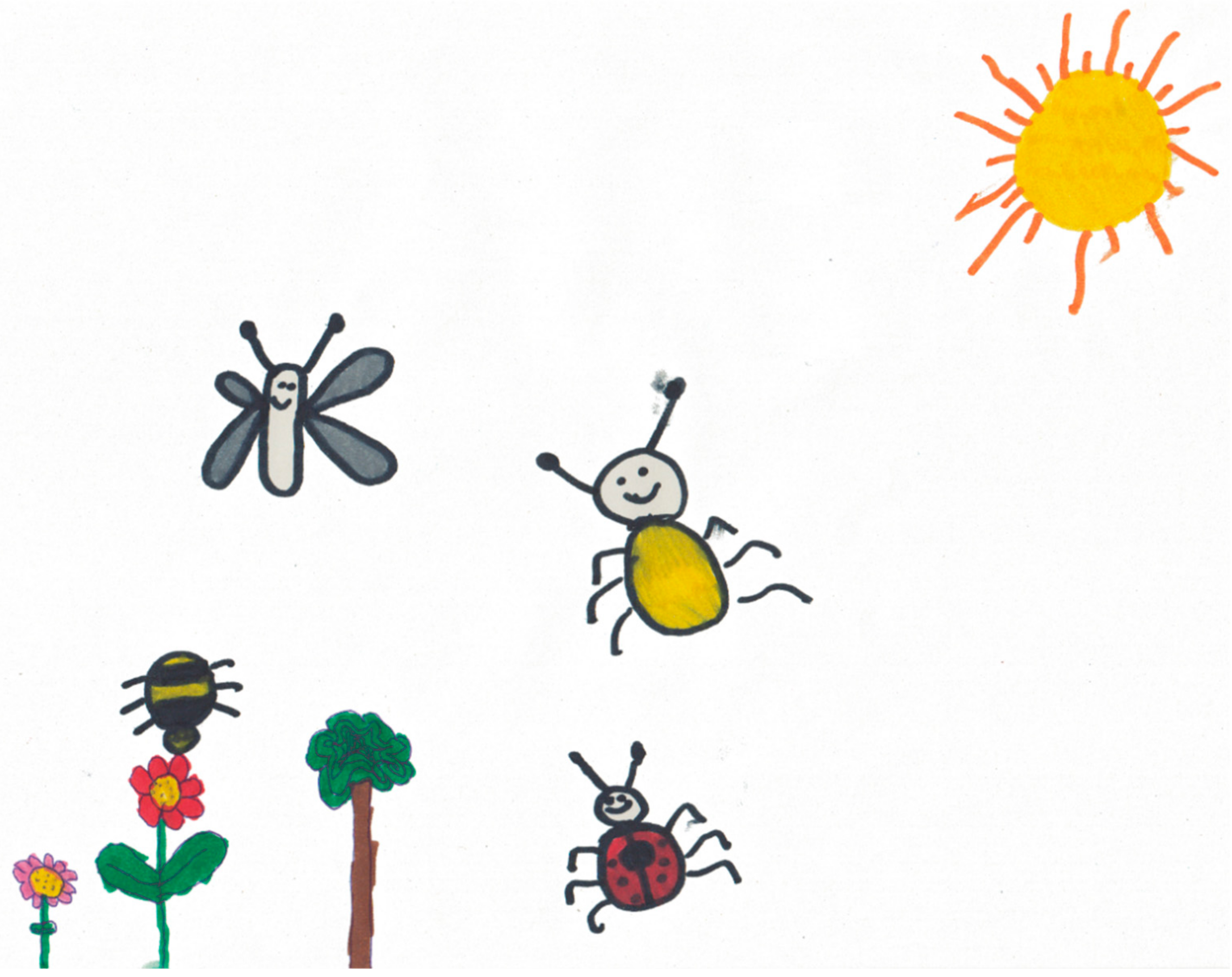
References
- Ahi, B. The world of plants in children’s drawings: The color preference and the effect of age and gender on these preferences. J. Baltic Sci. Educ. 2017, 16, 32–42. [Google Scholar]
- Allen, M. Early understandings of simple food chains: A learning progression for the preschool years. Int. J. Sci. Educ. 2017, 39, 1485–1510. [Google Scholar] [CrossRef]
- Anderson, J.L.; Ellis, J.P.; Jones, A.M. Understanding early elementary children’s conceptual knowledge of plant structure and function through drawings. CBE Life Sci. Educ. 2014, 13, 375–386. [Google Scholar] [CrossRef] [PubMed]
- Barraza, L.; Robottom, I. Gaining representations of children’s and adults’ constructions of sustainability issues. Int. J. Environ. Sci. Educ. 2008, 3, 179–191. [Google Scholar]
- Beauregard, C.; Papazian-Zohrabian, G.; Rousseau, C. Making sense of collective identity and trauma through drawing: The case study of a Palestinian refugee student. Intercult. Educ. 2017, 28, 113–130. [Google Scholar] [CrossRef]
- Bian, L.; Leslie, S.J.; Cimpian, A. Gender stereotypes about intellectual ability emerge early and influence children’s interests. Science 2017, 355, 389–391. [Google Scholar] [CrossRef] [PubMed]
- Cainey, J.; Humphrey, L.; Bowker, R. Drawing Experiences in Marine Conservation; Katz, P., Ed.; Drawing for Science Education; SensePublishers: Rotterdam, The Netherlands, 2017; pp. 97–109. [Google Scholar]
- Cainey, J.; Bowker, R.; Humphrey, L.; Murray, N. Assessing informal learning in an aquarium using pre- and post-visit drawings. Educ. Res. Eval. 2012, 18, 265–281. [Google Scholar] [CrossRef]
- Cho, Y.; Lee, D. ‘Love honey, hate honey bees’: Reviving biophilia of elementary school students through environmental education program. Environ. Educ. Res. 2017, 24, 445–460. [Google Scholar] [CrossRef]
- Dai, A. Learning from Children’s Drawings of Nature; Katz, P., Ed.; Drawing for Science Education; Drawing for Science Education: An International Perspective; SensePublishers: Rotterdam, The Netherlands, 2017; pp. 73–86. [Google Scholar]
- De Brito, M.; Jófili, Z.; dos Anjos, C. Ecological literacy—Preparing children for the twenty-first century. Early Child Dev. Care 2017, 187, 192–205. [Google Scholar] [CrossRef]
- Dentzau, M.W.; Gallard, A.J. Art to Capture Learning about the Longleaf Pine Ecosystem—Why a Picture Is Worth a Thousand Words; Mueller, M.P., Tippins, D.J., Eds.; EcoJustice, Citizen Science and Youth Activism: Situated Tensions for Science Education; Springer International Publishing: Cham, Switzerland, 2015; pp. 139–170. [Google Scholar]
- Emmons, N.A.; Kelemen, D.A. Young children’s acceptance of within-species variation: Implications for essentialism and teaching evolution. J. Exp. Child Psychol. 2015, 139, 148–160. [Google Scholar] [CrossRef] [PubMed]
- Flowers, A.A.; Carroll, J.P.; Green, G.T.; Larson, L.R. Using art to assess environmental education outcomes. Environ. Educ. Res. 2015, 21, 846–864. [Google Scholar] [CrossRef]
- Georgantopoulou, A.; Fragkiadaki, G.; Ravanis, K. Clouds as natural entities in preschool children’s thought. Educ. J. Univ. Patras UNESCO Chair 2016, 3, 114–128. [Google Scholar]
- Goodwin, T. Educating for Ecological Literacy. Am. Biol. Teach. 2016, 78, 287–291. [Google Scholar] [CrossRef]
- Haring, U.; Sorin, R. The CID lens: Looking at children’s drawings using content, interpretive, and developmental methods. Int. J. Arts Educ. 2014, 8, 15–29. [Google Scholar] [CrossRef]
- Hsueh, Y.; Zhou, Z.; Su, G.; Lee, J.; Kitzmann, K. Science learning in early years: Effects of the Chinese television series Big Bird Looks at the World. Glob. Media China 2017, 2, 183–196. [Google Scholar] [CrossRef]
- Izadkhah, Y.O.; Gibbs, L. A study of preschoolers’ perceptions of earthquakes through drawing. Int. J. Disaster Risk Reduct. 2015, 14, 132–139. [Google Scholar] [CrossRef]
- Kelemen, D.; Emmons, N.A.; Seston Schillaci, R.; Ganea, P.A. Young children can be taught basic natural selection using a picture-storybook intervention. Psychol. Sci. 2014, 25, 893–902. [Google Scholar] [CrossRef] [PubMed]
- Linder, L.A.; Bratton, H.; Nguyen, A.; Parker, K.; Phinney, S. Comparison of good days and sick days of school-age children with cancer reflected through their drawings. Qual. Life Res. 2017, 26, 2729–2738. [Google Scholar] [CrossRef] [PubMed]
- Loughland, T.; Reid, A.; Walker, K.; Petocz, P. Factors influencing young people’s conceptions of environment. Environ. Educ. Res. 2003, 9, 3–19. [Google Scholar] [CrossRef]
- Madden, L.; Liang, J. Young children’s ideas about environment: Perspectives from three early childhood educational settings. Environ. Educ. Res. 2017, 23, 1055–1071. [Google Scholar] [CrossRef]
- Malleus, E.; Kikas, E.; Marken, T. Kindergarten and primary school children’s everyday, synthetic, and scientific concepts of clouds and rainfall. Res. Sci. Educ. 2017, 47, 539–558. [Google Scholar] [CrossRef]
- Mouratidi, P.; Bonoti, F.; Leondari, A. Children’s perceptions of illness and health: An analysis of drawings. Health Educ. J. 2016, 75, 434–447. [Google Scholar] [CrossRef]
- Özsoy, S.; Ahi, B. Elementary School Students' Perceptions of the Future Environment through Artwork. Educ. Sci. 2014, 14, 1570–1582. [Google Scholar] [CrossRef]
- Pitman, S.D.; Daniels, C.B.; Sutton, P.C. Characteristics associated with high and low levels of ecological literacy in a western society. Int. J. Sustain. Dev. World Ecol. 2017, 25, 227–237. [Google Scholar] [CrossRef]
- Prokop, P.; Fančovičová, J.; Krajčovičová, A. Alternative conceptions about micro-organisms are influenced by experiences with disease in children. J. Biol. Educ. 2016, 50, 61–72. [Google Scholar] [CrossRef]
- Prokop, P.; Tunnicliffe, S.D. “Disgusting” animals: Primary school children’s attitudes and myths of bats and spiders. Eur. J. Math. Sci. Technol. Educ. 2008, 4, 87–97. [Google Scholar] [CrossRef]
- Roberts, L.N. “I Have a Connection!”: The Situated Sense-Making of an Elementary Student about the Role of Water in Modeled vs. Experienced Ecosystems; The University of Arizona: Tucson, AZ, USA, 2016. [Google Scholar]
- Rybska, E.; Tunnicliffe, S.D.; Sajkowska, Z.A. Children’s ideas about the internal structure of trees: Cross-age studies. J. Biol. Educ. 2017, 51, 375–390. [Google Scholar] [CrossRef]
- Salmon, A.K.; Lucas, T. Exploring young children’s conceptions about thinking. J. Res. Child. Educ. 2011, 25, 364–375. [Google Scholar] [CrossRef]
- Sanz Ortega, O. Acercamiento a la comprensión del concepto de ser vivo en educación infantil. Ikastorratza E-Revista Didáctica 2015, 15, 6. [Google Scholar]
- Snaddon, J.L.; Turner, E.C.; Foster, W.A. Children’s perceptions of rainforest biodiversity: Which animals have the lion’s share of environmental awareness? PLoS ONE 2008, 3, e2579. [Google Scholar] [CrossRef] [PubMed]
- Stokas, D.; Strezou, E.; Malandrakis, G.; Papadopoulou, P. Greek primary school children’s representations of the urban environment as seen through their drawings. Environ. Educ. Res. 2017, 23, 1088–1114. [Google Scholar] [CrossRef]
- Tardif-Williams, C.Y.; Bosacki, S.L. Gender and Age Differences in Children’s Perceptions of Self-Companion Animal Interactions Expressed through Drawings. Soc. Anim. 2017, 25, 77–97. [Google Scholar]
- Tsoi, K.H.; Chan, S.Y.; Lee, Y.C.; Ip, B.H.Y.; Cheang, C.C. Shark Conservation: An Educational Approach Based on Children’s Knowledge and Perceptions toward Sharks. PLoS ONE 2016, 11, e0163406. [Google Scholar] [CrossRef] [PubMed]
- Villarroel, J.D. Environmental judgment in early childhood and its relationship with the understanding of the concept of living beings. SpringerPlus 2013, 2, 87. [Google Scholar] [CrossRef] [PubMed]
- Villarroel, J.D. Young Children’s drawings of plant life: A study concerning the use of colours and its relationship with age. J. Biol. Educ. 2016, 50, 41–53. [Google Scholar] [CrossRef]
- Villarroel, J.D.; Antón, Á.; Zuazagoitia, D.; Nuño, T. Young children’s environmental judgement and its relationship with their understanding of the concept of living things. Environ. Socio-Econ. Stud. 2017, 5, 1–10. [Google Scholar] [CrossRef]
- Villarroel, J.D.; Ortega, O.S. A study regarding the spontaneous use of geometric shapes in young children’s drawings. Educ. Stud. Math. 2017, 94, 85–95. [Google Scholar] [CrossRef]
- Villarroel, J.D.; Villanueva, X. A Study Regarding the Representation of the Sun in Young Children’s Spontaneous Drawings. Soc. Sci. 2017, 6, 95. [Google Scholar] [CrossRef]
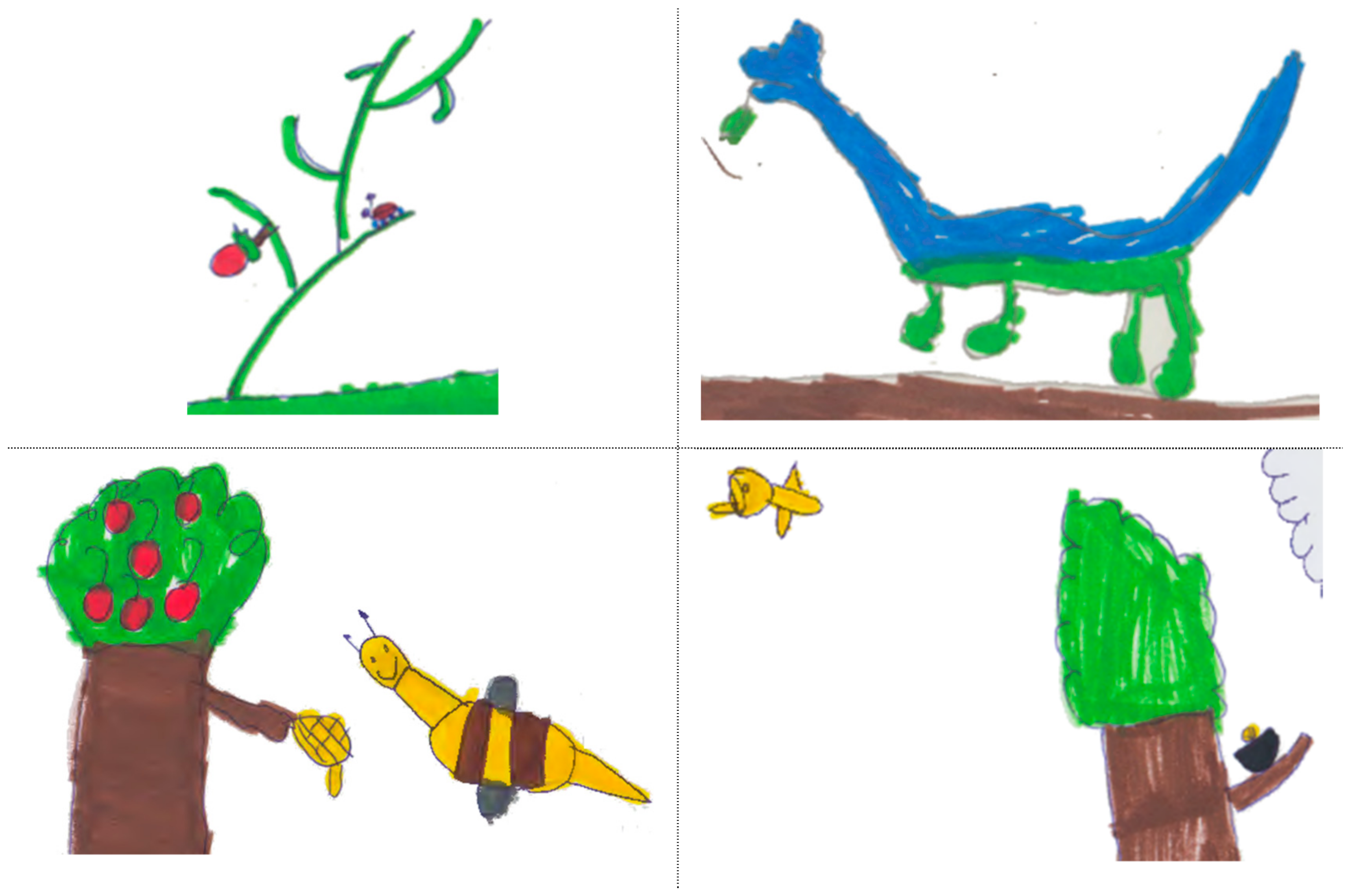
| Age at the Time of the Study | % | |
|---|---|---|
| First year at Primary Education | 6–7 | 30.2 |
| Preschool education | 5–6 | 27.7 |
| 4–5 | 42.1 |
| Invertebrate | Vertebrate | ||
|---|---|---|---|
| Snail | Dog | Songbird | Dinosaur |
| Earthworm | Cat | Eagle | Crocodile |
| Beetle | Wolf | Chick | |
| Honeybee | Tiger | Seagull | |
| Butterfly | Lion | Elephant | |
| Ant | Fish | Dolphin | |
| Ladybird | Orca | Rabbit | |
| Level | Age | (a) At Least One Invertebrate Drawn (N = 28) | (b) At Least One Animal in Connection with Plants (N = 19) |
|---|---|---|---|
| Penultimate year of Preschool Education | 4–5 | 17.9 | 0 |
| Finall year of Preschool Education | 5–6 | 25 | 31.6 |
| First year of Primary Education | 6–7 | 57.1 | 68.4 |
© 2018 by the authors. Licensee MDPI, Basel, Switzerland. This article is an open access article distributed under the terms and conditions of the Creative Commons Attribution (CC BY) license (http://creativecommons.org/licenses/by/4.0/).
Share and Cite
Villarroel, J.D.; Antón, A.; Zuazagoitia, D.; Nuño, T. A Study on the Spontaneous Representation of Animals in Young Children’s Drawings of Plant Life. Sustainability 2018, 10, 1000. https://doi.org/10.3390/su10041000
Villarroel JD, Antón A, Zuazagoitia D, Nuño T. A Study on the Spontaneous Representation of Animals in Young Children’s Drawings of Plant Life. Sustainability. 2018; 10(4):1000. https://doi.org/10.3390/su10041000
Chicago/Turabian StyleVillarroel, José Domingo, Alvaro Antón, Daniel Zuazagoitia, and Teresa Nuño. 2018. "A Study on the Spontaneous Representation of Animals in Young Children’s Drawings of Plant Life" Sustainability 10, no. 4: 1000. https://doi.org/10.3390/su10041000
APA StyleVillarroel, J. D., Antón, A., Zuazagoitia, D., & Nuño, T. (2018). A Study on the Spontaneous Representation of Animals in Young Children’s Drawings of Plant Life. Sustainability, 10(4), 1000. https://doi.org/10.3390/su10041000




